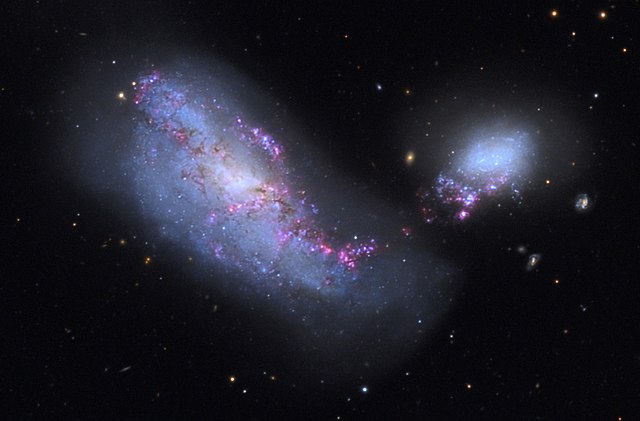
An article accepted for publication in “The Astrophysical Journal” reports evidence that the galaxy NGC 4490 has a double nucleus. A team of researchers led by Allen Lawrence of Iowa State University studied data collected using various telescopes to find traces of two different nuclei in NGC 4490. One of the two nuclei can be seen at optical wavelengths, the other is hidden by dust and can be seen only at infrared and radio wavelengths, capable of passing through those dusts. Lawrence saw the double nucleus about seven years ago when he was an astronomy student even though at the time he was about 70 years old.
NGC 4490 (top photo ©Adam Block/Mount Lemmon SkyCenter/University of Arizona) is classified as a barred spiral galaxy but its shape has now changed significantly due to its interaction with a smaller neighbor classified as NGC 4485. The Atlas of the Peculiar Galaxies features the pair NGC 4490 and NGC 4485 as ARP 269, distant approximately 23 million light years from Earth. That interaction is probably the initial phase of a galaxy merger, which for now determined the conditions for a remarkable star formation. NGC 4490 is surrounded by a giant gas cloud, which is why it has been nicknamed Cocoon Galaxy.
The relative closeness of the ARP 269 pair, the interaction between the two galaxies that could result in a merger in several million years and all that follows made NGC 4490 an interesting object of study. The discovery of a double nucleus in this galaxy suggests that it’s the result of a merger that occurred in the past but hasn’t been completed yet. The remarkable star formation and the presence of a gigantic cloud of gas that surrounds it would make even more sense if they were the consequences of a galaxy merger as well as an interaction with the small neighbor NGC 4485.
The story of the discovery of the double nucleus of the galaxy NGC 4490 is curious. Allen Lawrence is an astronomer a bit out of the ordinary since he’s 77 years old but he earned his master in astronomy only in 2018 starting a second career after working for decades as an electronic engineer. Together with professors of physics and astronomy at Iowa State University Charles Kerton and Curtis Struck and professor of physics and astronomy at East Tennessee State University Beverly Smith, he examined data collected with various telescopes at optical, infrared and radio wavelengths finding the traces of two distinct nuclei.
One of the two nuclei of NGC 4490 is visible at optical frequencies, the other at infrared and radio waves that can pass through the dust surrounding the second nucleus. According to the authors of this new research, it’s possible that astronomers who made observations of that galaxy in the past saw only one of the two nuclei because they used only one instrument and there was never a comparison between observations made in different electromagnetic bands before that would have revealed the presence of two nuclei.
Curtis Struck, who studies colliding galaxies, stressed that dual-nucleus galaxies are very rare, especially small ones like NGC 4490. Charles Kerton pointed out that this project demonstrates that using multiple wavelengths from different observations made on the ground and from space can really help us understand a particular object. In fact, his thesis was confirmed in recent years by various studies that obtained important results thanks to different instruments that offered information collected in different electromagnetic bands or even by combining observations of electromagnetic emissions with those of gravitational waves.


